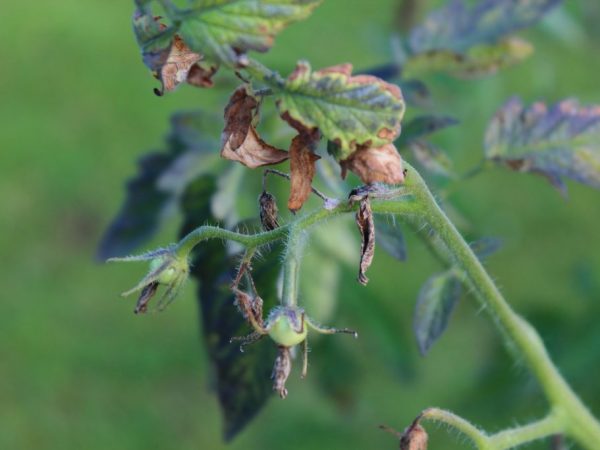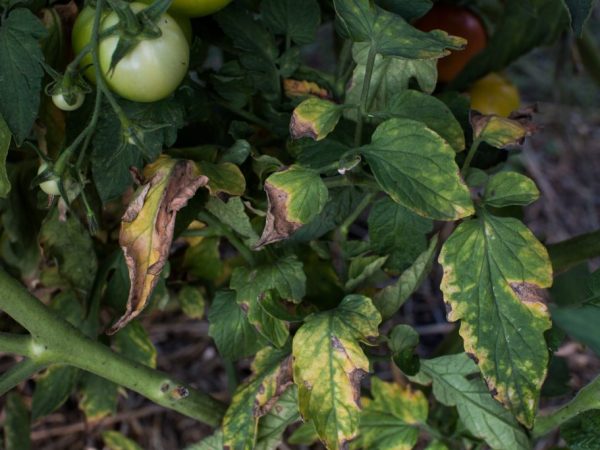Why do tomato leaves change color
A newly planted plant can give rise to excitement, because often the leaves of the seedlings begin to change color. Let us analyze what problems exist with tomato leaves and their causes.

The problem of color change in tomato leaves
White or black
If the leaves on the tomato bushes turn white, turn black or become gray, the acclimatization of the plant is difficult. Usually, seedlings are grown indoors, where they are looked after in compliance with all standards. When planted in open ground, the seedlings are stressed, which manifests itself in light or dark spots on the leaves.
The main causes of stress are:
- The sunlight is too bright. In this case, only the burnt areas change color.
- Temperature drops. This leads to darkening of the foliage.
- High wind speed or cold precipitation.
Spots of white or black color may appear when the root system is disturbed during planting. It is better to transplant seedlings in glasses, as this reduces the likelihood of breaking the stem or root.
The black color of the leaves of any plant, including tomato, indicates tissue necrosis. It will not be possible to restore the original color, the leaves simply dry out. This happens for various reasons: frost, illness, mechanical injury.
Precautions
If the leaves turn black, turn pale or have acquired a gray tint, preventive measures are taken. To prevent blackening or blanching of the leaves, the tomatoes are covered with medium density agrofibre. So that it does not fall and does not break the trunk of the plant, special metal arched canopies are installed. Every day, the film is lifted for several hours to obtain oxygen for the plant. After 2 weeks, the shelter is completely removed.
Any agrofibre of any brand and density is a breathable material, as opposed to a film. It allows air and moisture to pass into the shelter. Therefore, there is no need to take it off every day. In addition, plants do not breathe oxygen. They absorb carbon dioxide during photosynthesis and release oxygen.
Spraying is possible. For these purposes, use Zircon or Epin: 1 ml of the substance is diluted in 10 liters of water and the plant is sprayed the next day after planting.
Yellow or brown
Tomatoes growing in the greenhouse often change color.
Improper watering
To prevent the leaves from turning yellow or turning brown, moderate watering with warm water should be carried out. They do this only when the soil has already begun to dry and loosening measures have been taken. If you do not follow these rules, the root of the plant is violated, and the leaves immediately turn yellow.
Yellowing of the leaves indicates that the plants are experiencing a lack of light, or a lack of nitrogen, or both.
Brown spots

Damaged bushes should be removed from the site
Brown patches appear due to chlorotic curl disease. The lower parts of the plant turn yellow and the upper part withers.This viral disease cannot be treated, therefore, all damaged bushes are removed, and the soil is treated with disinfectants such as Tsifox.
Brown spots are necessarily a sign of pest or disease damage. The shape, size, location of spots on the leaves will tell an experienced agronomist the reason for their appearance and ways of possible elimination.
Lack of fertilizer
Outdoor tomatoes may turn yellow or brown due to lack of fertilizer. To get rid of this problem, feed with complex substances and alternate organic matter (humus or droppings) with minerals.
It is advisable to fertilize the soil once a week.
Purple or blue
Tomatoes turn blue for two interrelated reasons:
- sudden changes in temperature;
- insufficient amount of necessary substances in the soil.
If the stem and bottom of the bush become purple, the seedlings have started to freeze and have stopped growing. The temperature for the normal development of the tomato bush should be in the range of 18-20 ° C. If the leaves or stem turn purple, the temperature has dropped to 13 ° C. For this reason, it is immediately necessary to normalize the temperature regime. If no changes have occurred, the reason lies in the insufficient amount of chemical elements in the soil.
If the leaves turn brown, rust or turn red, the bush needs phosphorus, so you should immediately apply a complex of fertilizers. If the treatment is successful, the red, brown or purple areas brighten, the appearance of the plant improves.
Foliage curling and drying
If dry leaves curl upward, the plant lacks nitrogen. It needs a complex of mineral fertilizers, which is applied at the very root after watering.
Leaves curling downward are a signal of a lack of phosphorus.
A large amount of moisture accumulates in the lower part of the garden. The temperature in this place is gradually decreasing. Tomatoes in cold conditions are not able to take nutrients from the soil, as a result, the leaves of the seedlings gradually curl.
Among other things, the foliage dries up due to a lack of nutrients and an abundance of sunlight. If the leaves become dry or plaque has formed on them, the problem is in the disruption of the nutrition of the soil and the plant itself, you should immediately get rid of the damaged areas.
Conclusion
If the tomato bushes darken, become covered with pale or dark dots, dry out from burns, in most cases improper care is to blame. That is why gardeners first of all need to pay attention to the rules of planting and agricultural technology.


